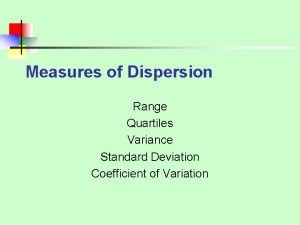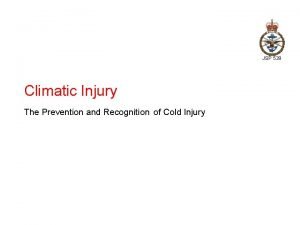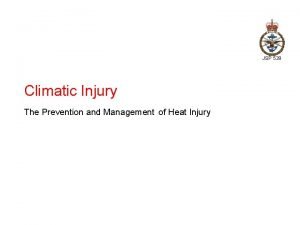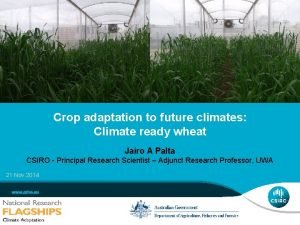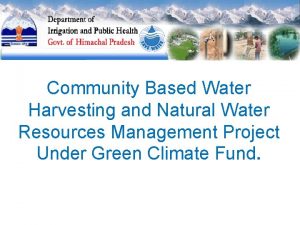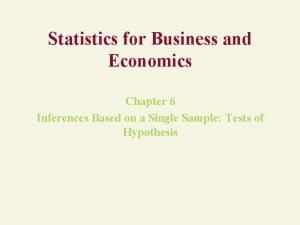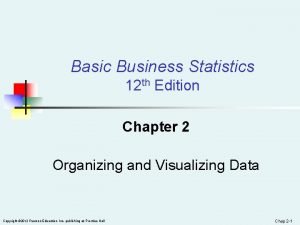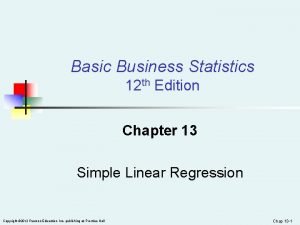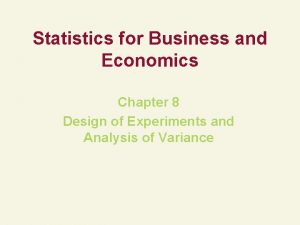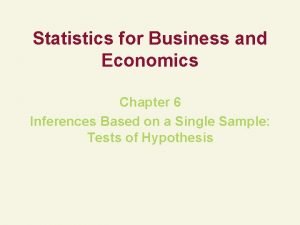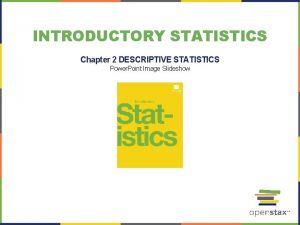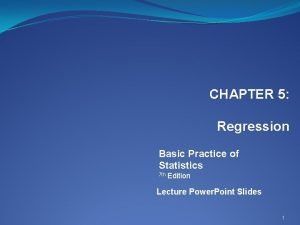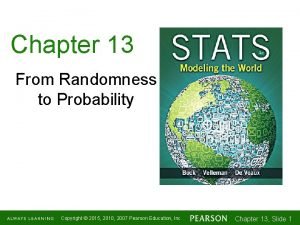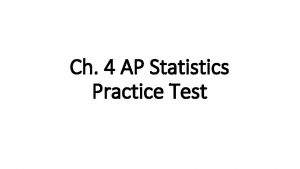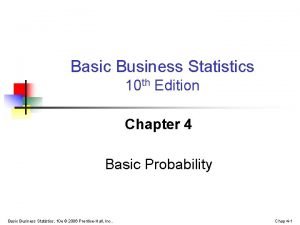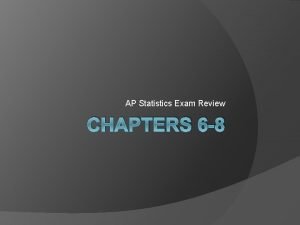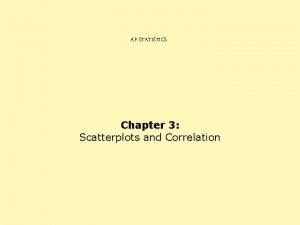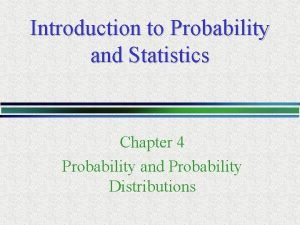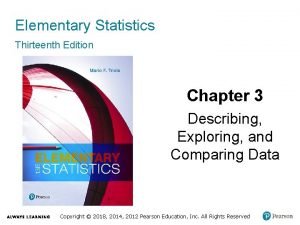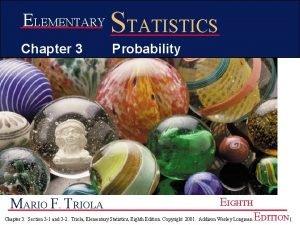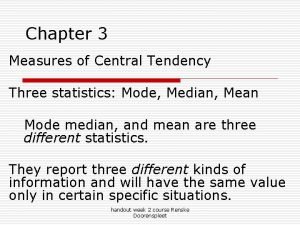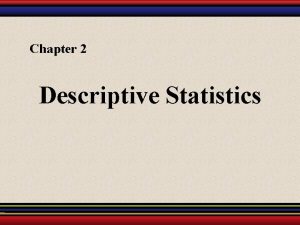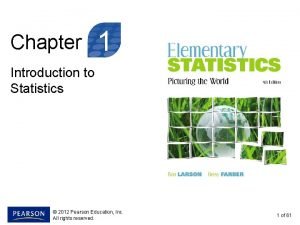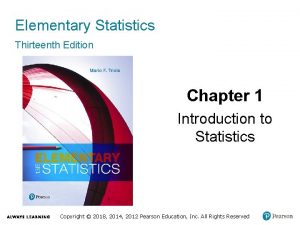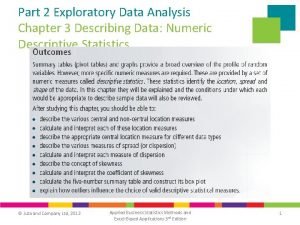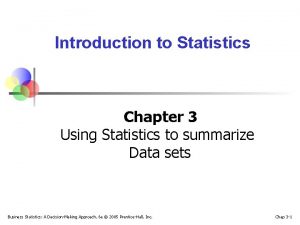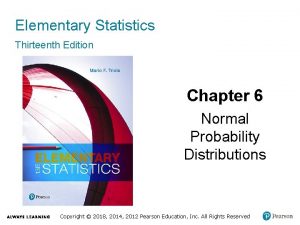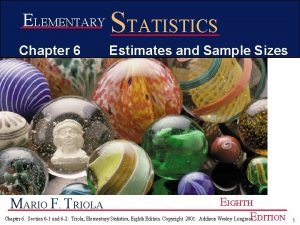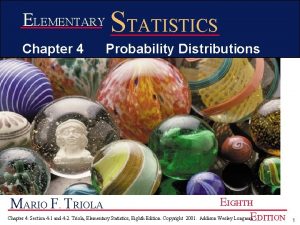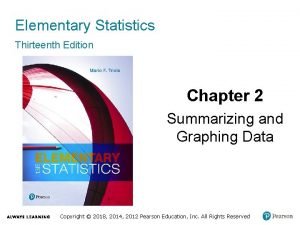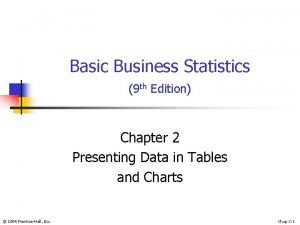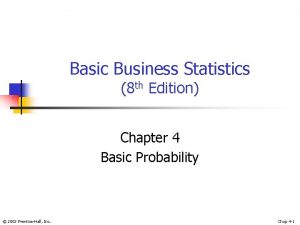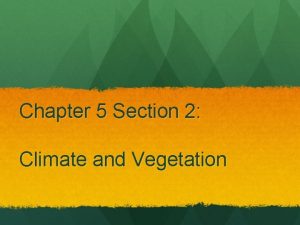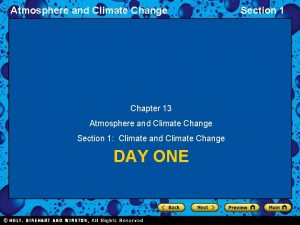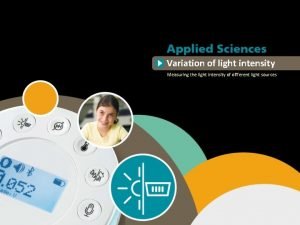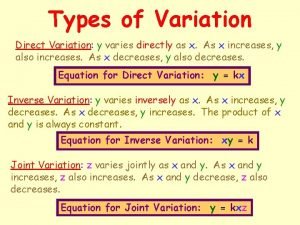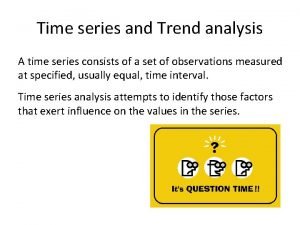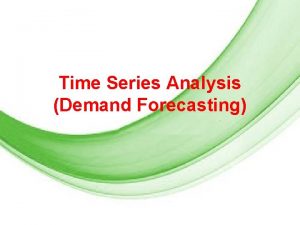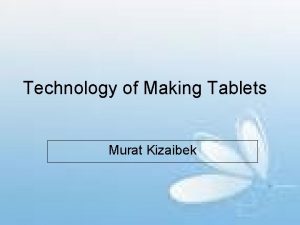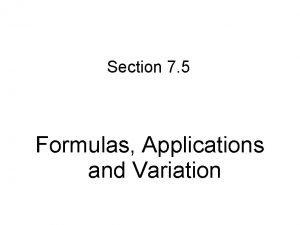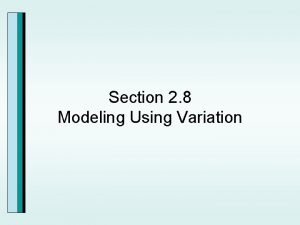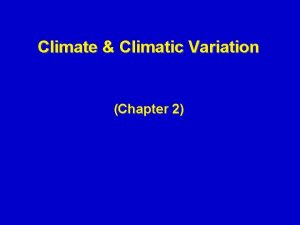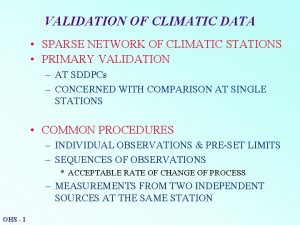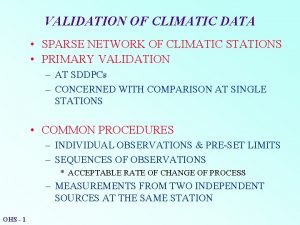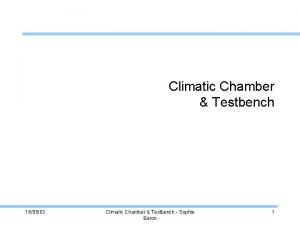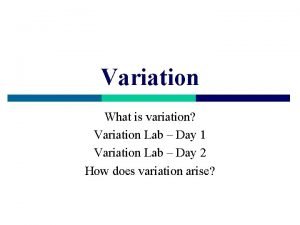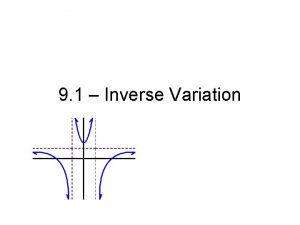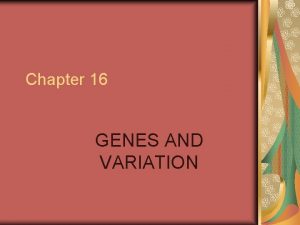Climate Climatic Variation Chapter 2 CLIMATE 1 Statistics
















































![Radiation Spectrum Emission Black Body Curves 255 K 6, 000 K Wavelength [m] Solar Radiation Spectrum Emission Black Body Curves 255 K 6, 000 K Wavelength [m] Solar](https://slidetodoc.com/presentation_image_h2/a9f373458de820e8cefd531b0df8165f/image-49.jpg)
![Daily Solar Radiation at Top of Atmos. [106 J-m-2] Daily Solar Radiation at Top of Atmos. [106 J-m-2]](https://slidetodoc.com/presentation_image_h2/a9f373458de820e8cefd531b0df8165f/image-50.jpg)





























- Slides: 79

Climate & Climatic Variation (Chapter 2)

CLIMATE = 1. Statistics of Weather Daily Precipitation - Iowa/Nebraska

CLIMATE = 1. Statistics of Weather 2. The expected weather + departures from expected weather

CLIMATE Reflects the geophysical processes active at a location…

Northeastern Siberia

Namibia

Amazon Rainforest

CLIMATE = …and how they might change (e. g. , seasonally)… Winter Daily Precipitation - Iowa/Nebraska

CLIMATE = …and how they might change (e. g. , seasonally)… Summer Daily Precipitation - Iowa/Nebraska

… and in the future! (and of course the past)

CLIMATE 1. Implies samples over a period of time. How long? How frequent? 2. WMO standard: 30 years - which 30? - paleoclimate? 3. There is no universal standard, but must define the interval for the topic at hand

CLIMATE 1. Has regular cycles …

Grassland - Net Radiation Cycles FLH FSH Diurnal Dry Lake - Net Radiation FSH FLH

Cycles Annual Soil Temperature at depths marked

CLIMATE 1. Has regular cycles … 2. … with other types of variability superimposed …

Climatic Variation and Change (IPCC TAR, Ch. 2) Note: Trends, Abrupt Change, Stationarity

Climatic Variation and Change (IPCC TAR, Ch. 2) Note: Quasi-periodic Increased range of variability

Climatic Variation and Change Additional Factors 1. Abrupt change - external conditions (e. g. , solar output) - passing a threshold (e. g. ice caps melting) internal feedbacks 2. Multiple climate states from the same external conditions

The Climate System (IPCC TAR, Ch. 1)

The Climate System (IPCC TAR, Ch. 1)

The Climate System Three important controling factors: 1. Latitude 1. - insolation 2. Elevation - temp. decrease with height 3. Closeness to oceans - heat reservoir

The Climate System Water in the climate system: (Peixoto & Oort, 1992)

The Climate System

The Climate System Mean extreme temperatures and differences (˚C) : Northern Hemisphere 8. 0 21. 6 (Jan) (Jul) Southern Hemisphere 10. 6 (Jul) Globe 12. 3 16. 1 (Jan) (Jul) 16. 5 (Jan) 13. 6 6. 5 3. 9

Thermal Inertia of Oceans Annual Temperature Range (Wallace & Hobbs, 1979)

The Climate System (Michael Pidwirny, DLESE, 2004)

The Climate System Subsystems 1. Atmosphere - rapid changes - links other subsystems - greenhouse gases 2. Ocean - slow evolution (“memory”, “flywheel”) - chemical role, esp. CO 2 3. Land - range of time scales - cryosphere & biosphere roles - location of continents

Cryosphere Area (106 km 2) Sea-lev. equiv. (m) Max extent (%) Min extent (%) 24 % (Feb) 4 % (Aug) 13 % (Oct) 7 % (Feb) N. H. Land snow & ice Sea ice 2. 2 (Grnl: 1. 7) 7. 8 8. 9 Total 11. 0 S. H. Land snow & ice Sea ice Total Note: 13. 0 (Antr: 13) 73. 5 4. 2 17. 2 Time scales, albedo effects

Biosphere Note: albedo, evapotranspiration, surface roughness, gas exchanges (esp. CO 2)

Feedbacks Internal couplings through linking processes Amplify or diminish initial induced climate change

Negative Feedback: Example How does Earth’s temperature get established and maintained?

Solar Constant At photosphere surface, solar flux ~ 6. 2. 107 W-m-2

Solar Constant At photosphere surface, solar flux ~ 6. 2. 107 W-m-2 At Earth’s orbit, solar flux ~ 1360 W-m-2

Planetary Albedo Scattering: air molecules, aerosols Reflection: clouds Surface albedo

What is Earth’s temperature? Balance: Radiation in = Radiation out a Incoming = 1360 W-m-2 x (1 -albedo) x (area facing sun) = 1360 x (1 -0. 3) x pa 2 = 1. 2. 10+17 W

What is Earth’s temperature? Balance: Radiation in = Radiation out a Incoming = 1360 W-m-2 x (1 -albedo) x (area facing sun) = 1360 x (1 -0. 3) x pa 2 = 1. 2. 10+17 W Outgoing = s. T 4 x (area emitting) ; i. e. , black body = s. T 4 x 4 pa 2

What is Earth’s temperature? Balance: Radiation in = Radiation out a Incoming = 1360 W-m-2 x (1 -albedo) x (area facing sun) = 1360 x (1 -0. 3) x pa 2 = 1. 2. 10+17 W Outgoing = s. T 4 x (area emitting) ; (i. e. , black body) = s. T 4 x 4 pa 2 Balance implies T = {0. 7(1360 W-m-2)/4 s}1/4 = 255 K = -18 o. C

What is Earth’s temperature? Balance: Radiation in = Radiation out a Balance implies T = -18 o. C Observed surface T = +15 o. C Difference? Must account for atmosphere (greenhouse effect).

What if temperature decreases? a The same: Incoming = 1. 2. 10+17 W Outgoing = s. T 4 x (area emitting) = s. T 4 x 4 pa 2

What if temperature decreases? a These are the same: Incoming = 1. 2. 10+17 W Outgoing = s. T 4 x (area emitting) = s. T 4 x 4 pa 2 But for T < 255 K: Þ imbalance Þ Incoming solar exceeds outgoing IR Þ net energy input Þ T increases ~ Negative Feedback ~

Negative Feedback 1. Perturb climate system 2. Negative feedback moves climate back toward starting point 3. A stabilizing factor

Positive Feedback: Example How does Earth’s temperature get established and maintained?

Greenhouse Effect IR radiation absorbed & re-emitted, partially toward surface Solar radiation penetrates

Greenhouse Effect IR radiation absorbed & re-emitted, partially toward surface Net IR: ~25 -100 W-m Emitted IR: ~200 -500 W-m

Greenhouse Effect Cooler atmosphere: - Less water vapor - Less IR radiation absorbed & re-emitted Solar radiation penetrates

Greenhouse Effect Cooler atmosphere: - thus less surface warming - cooler surface temperature Solar radiation penetrates

Positive Feedback 1. Perturb climate system 2. Positive feedback moves climate away from starting point 3. A destabilizing factor Other examples (textbook): - ice-albedo feedback - CO 2 -ocean temperature feedback

Feedbacks Distinguish between: 1. external forcing change - e. g. , insolation, volcanism - often predictable 2. Internal feedback mechanisms - nonlinear, coupled interactions - generally less predictable (stochastic)
![Radiation Spectrum Emission Black Body Curves 255 K 6 000 K Wavelength m Solar Radiation Spectrum Emission Black Body Curves 255 K 6, 000 K Wavelength [m] Solar](https://slidetodoc.com/presentation_image_h2/a9f373458de820e8cefd531b0df8165f/image-49.jpg)
Radiation Spectrum Emission Black Body Curves 255 K 6, 000 K Wavelength [m] Solar (shortwave, visible) Terrestrial (longwave, infrared)
![Daily Solar Radiation at Top of Atmos 106 Jm2 Daily Solar Radiation at Top of Atmos. [106 J-m-2]](https://slidetodoc.com/presentation_image_h2/a9f373458de820e8cefd531b0df8165f/image-50.jpg)
Daily Solar Radiation at Top of Atmos. [106 J-m-2]

Earth’s mean annual radiation and energy balance

Absorbed Solar Radiation

Outgoing Terrestrial Radiation

Key Energy Fluxes at Surface Sensible Heat FSH ≈ - r Cp. CH(Tair-Ts) FSH = r Cp(w. T)s Tair Ts CH = CH(V, zo, dq/dz)

Surface Sensible Heat Flux (Peixoto & Oort, 1992)

Key Energy Fluxes at Surface Latent Heat CW = CW(V, zo, dq/dz) but also CW = CW(physiology) soil moisture CW µ leaf temp. sunlight CO 2 level FLH ~ - r. Cp. CW{eair-esat(Ts)}

Surface Evaporation (Peixoto & Oort, 1992)

Grassland - Net Radiation Cycles FLH FSH Diurnal Dry Lake - Net Radiation t Less cooling by evaporation FSH t Ts increases t FSH larger FLH

Role of Albedo Scattering: air molecules, aerosols Reflection: clouds Surface albedo Ocean Snow Crop Forest Cities 2 -6% 40 -95% 15 -25% 5 -10% 14 -18%

Role of Albedo changes with latitude - changing land surface - changes in incidence angle Albedo changes with time - land changes (e. g. , ice sheets) - cloud cover

Role of Albedo changes with latitude

Role of Greenhouse Gases Primary gases: water vapor, CO 2, methane (CH 4), nitrous oxide (N 2 O), ozone (O 3)

Time Scales of Climatic Variation (IPCC TAR, Ch. 2) Note: Magnitude of changes Reduced “detectability” farther back in time

Time Scales of Climatic Variation (IPCC TAR, Ch. 2) Different size of changes

Time Scales of Climatic Variation


Earth’s Orbital Parameters Vernal Equinox (~ March 21) Aphelion (~ July 5) Perihelion (~ Jan 3)

Earth’s Orbital Parameters b a Eccentricity = SQRT(a 2 - b 2)/a ; for circle, = 0 Longitude of perihelion (one choice: angle from NH vernal equinox) Tilt of rotation axis (obliquity)

Variability of Earth’s Orbital Parameters

Earth’s Orbital Parameters b a Periodic variations Current Range ~ Period (yr. ) ~ 0. 02 [0. 0 - 0. 05] 95, 800 Longitude of perihelion ~ 270˚ [0˚ - 360˚] 21, 700 Obliquity [21. 8˚ - 24. 4˚] 41, 000 Eccentricity: 23. 4˚

Earth’s Orbital Parameters b a Seasonal efffect of variations (little annual effect) Eccentricity: intensity of seasons Longitude of perihelion NH-SH differences in summer insolation Obliquity extratropical summer-winter differences

Variability of Earth’s Orbital Parameters

Changes in Earth’s Orbit Some paleo-records can resolve different frequencies in an orbital element’s variability (e. g. , 19, 000 and 23, 000 yr periods in precession). Some can detect “beat” frequencies. Relative importance of frequencies changes with time - and may not correspond to dominant frequencies in climatic response. Shorter, lower amplitude frequencies might be important for decadal-millenial climate changes.

Changes in Earth’s Orbit Changes in Earth’s orbit affect - annual insolation cycle - past glacial-interglacial variability Croll (late 1800 s) Milankovitch (1941) Berger (1970 s)

Changes in Earth’s Orbit Changes in Earth’s orbit affect - annual insolation cycle - past glacial-interglacial variability Optimum conditions: minimum obliquity, high eccentricity, aphelion during NH summer - allow snow to persist through summer - allow relatively warm winter (increased subtropical evap. & increased snowfall) - transition seasons may also be important for snow-cover expansion

Variability of Earth’s Orbital Parameters

Milankovitch Theory

Scales of Climate Global Regional Microscale Microscale Microclimate B Plant B Soil Pathogen D Chemicals itus Management Insect B Chemicals Human Influences Erosion Plant A Soil Pathogen B Insect A ls ica Detr ls ica em Ch Soil A Soil C Soil B H 2 O, temperature, nutrients, microbes, soil carbon, trace chemicals H 2 O, temperature, nutrients, microbes, soil carbon, trace chemicals Particulate Deposition, Precipitation, Solar Radiation, IR Crop B em Ch Management trace gases, shading, particulate matter Air-Transported Pathogen B Solar, IR, wind, CO 2, CO, NOx, SO 2, H 2 O, temperature, trace gases, shading, particulate matter Air-Transported Pathogen A Microclimate C Crop A Surface slope, IR Radiation, Evaporation, Biogeochemicals Microscale Solar, IR, wind, CO 2, CO, NOx, SO 2, H 2 O, temperature, Microclimate A Microscale Hydrology, Soil Microbiology, Soil Biochemistry Field Field Regional Continental Scales of Landforms Field Regional Field

Climate & Climatic Variation (Chapter 2) END
 Direct variation constant of variation
Direct variation constant of variation Direct and inverse graphs
Direct and inverse graphs Prediction interval formula
Prediction interval formula Range measure
Range measure Chhattisgarh agro climatic zones
Chhattisgarh agro climatic zones Types of dramatic structure
Types of dramatic structure Agroclimatic zones of chhattisgarh
Agroclimatic zones of chhattisgarh Climatic injuries
Climatic injuries Jsp539
Jsp539 Environmental considerations pdhpe
Environmental considerations pdhpe Agro climatic zones of chhattisgarh
Agro climatic zones of chhattisgarh Climatic
Climatic Agro climatic zones of himachal pradesh
Agro climatic zones of himachal pradesh Introduction to statistics what is statistics
Introduction to statistics what is statistics Climate change 2014 mitigation of climate change
Climate change 2014 mitigation of climate change One proportion z test
One proportion z test Ap statistics chapter 27 quiz
Ap statistics chapter 27 quiz Dcova method
Dcova method Dcova meaning
Dcova meaning Chapter 7 ap stats test
Chapter 7 ap stats test The w's in statistics
The w's in statistics Chapter 8 statistics
Chapter 8 statistics Statistics for business and economics chapter 6 solutions
Statistics for business and economics chapter 6 solutions Introductory statistics chapter 2 answers
Introductory statistics chapter 2 answers 5% guideline for cumbersome calculations
5% guideline for cumbersome calculations The practice of statistics chapter 5
The practice of statistics chapter 5 Ap statistics chapter 13 from randomness to probability
Ap statistics chapter 13 from randomness to probability Introduction to statistics chapter 1
Introduction to statistics chapter 1 Ap stats practice test multiple choice
Ap stats practice test multiple choice Business statistics chapter 4
Business statistics chapter 4 Ap statistics chapter 6
Ap statistics chapter 6 Ap statistics chapter 3
Ap statistics chapter 3 How to lie with statistics pdf
How to lie with statistics pdf Probability and statistics chapter 3 test answer key
Probability and statistics chapter 3 test answer key Chapter 4 probability statistics
Chapter 4 probability statistics Elementary statistics chapter 3
Elementary statistics chapter 3 Elementary statistics chapter 3
Elementary statistics chapter 3 Statistics chapter 3 measures of central tendency
Statistics chapter 3 measures of central tendency Elementary statistics chapter 2
Elementary statistics chapter 2 Chapter 1 introduction to statistics
Chapter 1 introduction to statistics Elementary statistics 13th edition chapter 1
Elementary statistics 13th edition chapter 1 Chapter 1 the nature of probability and statistics
Chapter 1 the nature of probability and statistics Jeopardy statistics
Jeopardy statistics Business statistics i com part 2 chapter 3
Business statistics i com part 2 chapter 3 Introduction to statistics chapter 3 answers
Introduction to statistics chapter 3 answers Elementary statistics chapter 6
Elementary statistics chapter 6 Elementary statistics chapter 4
Elementary statistics chapter 4 Margin of error statistics
Margin of error statistics Elementary statistics chapter 4
Elementary statistics chapter 4 Elementary statistics chapter 2
Elementary statistics chapter 2 Ap statistics chapter 17
Ap statistics chapter 17 Business statistics chapter 2
Business statistics chapter 2 Business statistics chapter 4
Business statistics chapter 4 Chapter 21 section 2 climate and vegetation
Chapter 21 section 2 climate and vegetation Chapter 24 patterns of climate answer key
Chapter 24 patterns of climate answer key Chapter 21 section 2 climate and vegetation
Chapter 21 section 2 climate and vegetation Atmosphere
Atmosphere Chapter 13 atmosphere and climate change
Chapter 13 atmosphere and climate change World geography chapter 3 weather and climate
World geography chapter 3 weather and climate Variation of light
Variation of light Formula direct proportion
Formula direct proportion Kinds of variation
Kinds of variation Irregular variation in time series example
Irregular variation in time series example How to calculate average seasonal variation
How to calculate average seasonal variation Direct variation as a power
Direct variation as a power Usp tablet weight variation limit
Usp tablet weight variation limit Sociolinguistics
Sociolinguistics Male genital variation
Male genital variation Evolution of populations section 16-1 genes and variation
Evolution of populations section 16-1 genes and variation The drag force f on a boat varies jointly
The drag force f on a boat varies jointly Modeling using variation calculator
Modeling using variation calculator Difference between regional and social dialect
Difference between regional and social dialect Compendial testing definition
Compendial testing definition Variation of price clause
Variation of price clause 11-1 inverse variation answers
11-1 inverse variation answers Inverse variation
Inverse variation Variation west magnetic best
Variation west magnetic best Which graph represents a direct variation?
Which graph represents a direct variation? Allomorphic variation
Allomorphic variation Artificial selection vs natural selection
Artificial selection vs natural selection



